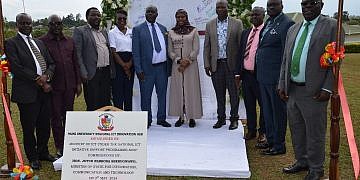Uganda has officially signed a contract with Turkish firm Yapi Merkezi to construct a 272-kilometre Standard Gauge Railway (SGR), marking a major milestone in the country’s infrastructural development.
The $3 billion( about shs10.8 trillion) agreement was signed on Monday in Kampala by Uganda’s Permanent Secretary for Works, Bageya Waiswa, and Yapi Merkezi Vice Chairman Erdem Arioglu.
Speaking at the signing ceremony, Uganda’s Minister for Works and Transport, Gen. Katumba Wamala, expressed optimism about the project’s timely implementation.
“People are welcome to see and monitor progress in the next 48 months. There is no retreat, no surrender as we move forward to realize a fully constructed SGR that will transform our country’s fortunes,” said Wamala.
The minister revealed that significant progress had already been made in preparing the Malaba-Kampala section of the SGR. Approximately 150 kilometres of the required 272-kilometre right of way between Malaba and Mayuge—about 54% of the total route—has been secured.
Pre-construction activities have also included conducting feasibility studies, aligning SGR plans with other infrastructure projects, and initiating plans to extend electricity to SGR substations. Additionally, the project is committed to local content, with 40% of the contract value earmarked for Ugandan participation.
Shift from China to Turkey
Uganda’s initial contract to build the SGR had been signed with China Roads and Bridges Corporation (CRBC). However, that project stalled after Uganda failed to secure the necessary funding, leading the Chinese company to pull out. The new deal with Yapi Merkezi signals Uganda’s determination to proceed with this vital infrastructure.
The Ministry of Finance Permanent Secretary, Ramathan Ggoobi, hailed the agreement as a key step towards enhancing Uganda’s economic development.
“The Malaba-Kampala SGR will form the backbone of our land transportation system, offering cheaper and faster movement of goods and services,” Ggoobi said, adding that the project will reduce the cost of transporting goods from Mombasa to Kampala by 50% and slash transit times from seven days to just one.
He further noted that the SGR is part of a broader regional initiative involving Uganda’s Northern Corridor partners—Kenya, Rwanda, South Sudan, and the Democratic Republic of Congo. The railway will also connect to Tanzania via Lake Victoria, enhancing Uganda’s role as a transportation hub in East Africa.
Background on the Standard Gauge Railway (SGR)
The Standard Gauge Railway project is part of Uganda’s efforts to modernize its transport infrastructure and facilitate trade. The SGR is designed to replace the ageing metre-gauge railway, offering a faster and more efficient way to transport goods across the country and the region. Uganda’s SGR project is part of a larger East African initiative that aims to link several countries through high-capacity railways. These projects are expected to boost regional trade, reduce transportation costs, and ease the movement of goods between key ports such as Mombasa in Kenya and cities like Kampala.
Uganda’s SGR line is primarily focused on the Malaba-Kampala route, a key trade corridor. The project is expected to play a pivotal role in connecting Uganda to other countries, thus integrating the region’s economies and fostering economic growth.








































